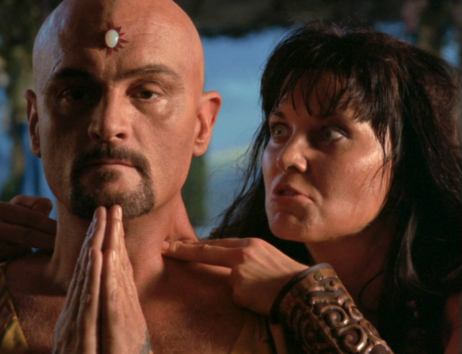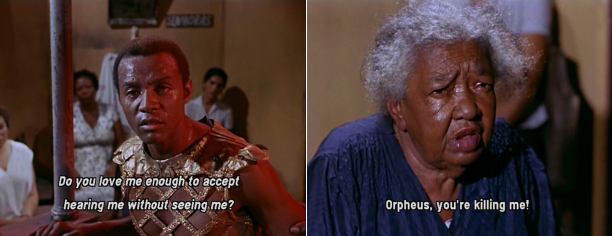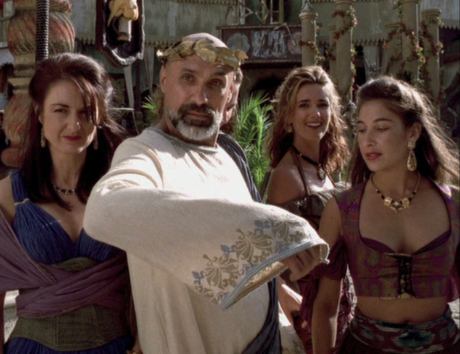In A Tale of Two Muses, we saw a comical twist on the religious preacher combined with the Stranger from The Bacchae. In Crusader, we meet another Dionysiac villain: Najara, a religious knight in the Joan-of-Arc vein, who follows the pattern of the insightful villain which began with Callisto all the way up to this season's Alti. Najara threatens to break up Xena's friendship with Gabrielle by posing as a much more suitable mentor. Like Xena, she wants to defeat the slave trade, but unlike Xena, she wants to settle down and run a hospice; Xena's capable of that, but her quest doesn't leave time for it--she's being pursued by another destiny altogether. Najara derives her power from the Djinn, sent by the Light: once again, we're given a religious figure who seems to represent the arrival of the biblical God, only to discover a wolf in sheep's clothing. It's not clear which religion Najara represents: is she Christian, like Joan of Arc? Muslim? Is this land Palestine, the battleground for Christians and Muslims during the Crusades? All these seem to be evoked, and I think they point to her true nature. If we consult Mircea Eliade's Patterns in Comparative Religion," pp. 282-5, we'll find all these elements. Najara's name may come from "vijara-nadi," a Sanskrit phrase meaning "that which regenerates." It's associated with soma, a regenerative drug in the Indian epic Mahabharata, but which is also associated (e.g. Huxley's Brave New World) with a pleasure drug that represents a shallow enlightenment too easily achieved. An easily-achieved enlightenment has already been seen, on Hercules, in The Lost City, and remembering the Lotus Eaters of The Odyssey, we know we're in Ulysses' sphere of influence again. This episode precedes the India arc, in which Gabrielle will face much bigger challenges: Najara represents the path of easily-made choices in a world seen in draconian black and white. In the same passage, Eliade describes a related Mesopotamian cult from the legend of Gilgamesh: a maiden who tempts him with immortality; she wears a veil, and her role in the epic is similar to that of Calypso in The Odyssey. We've already seen several Calypso figures in Xena, and in the first Hercules movie, Hercules and the Lost Kingdom, she was introduced as Queen Omphale. The soma, ambrosia, or lotus that she offers was, according to Eliade, originally the vine:
Speaking of The Price, that episode is followed up this season by Daughter of Pomira. Like Forgiven, it pays homage to John Ford's The Searchers, and also seems to share elements with second season Hercules episode Promises. The Horde of The Price is given a name, the Pomira, which seems to come from Colleen McCullough's Masters of Rome series: each book comes with a glossary, and there we'll find "pomerium," the sacred boundary enclosing the city of Rome; everything outside of it was not Rome, merely a territory of it. This matches the attitude of the Athenian soldiers of The Price, defending their walls against the Horde, and the beast-like creatures of the Horde match the "Primords" of the previous season's Hercules episode, Promise: they seem to us at first savage animals, then later, creatures on the run from far more civilized monsters. Though it seems to stand unrelated to other episodes in this season, we can actually count this episode as a shadow member of the Caesar arc, which will reach its dramatic climax after Xena and Gabrielle return from Indian at the end of this season.   Devi introduces Eli, a Christ-like figure based loosely on the idea of Jesus travelling to India before his ministry began, influenced by the philosophy of the East. Here, Eli is a magician--a fake one, since there are no real magicians in the Xenaverse, only those with religious powers. As it happens, his powers are quite real; they are those of the shaman, who bridges the gap between heaven and earth. According to Eliade, the Indian rope trick is the religious equivalent of the shaman's ecstatic dance, and Eli realizes that his ability to heal his father's best friend when he was a boy was the sign of a higher calling as a spiritual healer (Eli's biblical name may be inspired in part by Eliade's!01). His age at the time, thirteen, is about the age that a shaman discovers his or her vocation. This episode's original title was Smoke and Mirrors, which makes us recall the original smoke and mirror story of Altared States in the first season. With Eli we're finally getting closer to the One God that's been hinted at since the beginning. It's fitting that the story opens with a bait-and-switch about who the "avatar" really is; we first think it's Gabrielle, but as her behavior becomes more bacchic than divine, we see a familiar pattern emerge. The villain is Tataka, a demon that possesses Gabrielle, who, like Eli, wants the power to heal, but now finds herself transformed into a vain, glamorous creature who wants the adoration of the crowd. This is an inverse of the Tataka episode from the Ramayana. Tataka was a child whose father wished for a son instead. With the death of her husband, she became unhinged with grief, and was cursed by a great rishi whom she made advances on: "Shameless woman! Be a rakshai (demon) as monstrous as your heart is full of darkness. Your beauty will be a thing of the past. You will feed on flesh, and all the creatures of the earth will hate you."02 She lost her beauty, and became a terrifying creature of the jungle. Rama, the hero, frees her from her curse by killing her, transforming her back to her beautiful self in death. This is, by now, a familiar scene on Xena and Hercules, and we first saw it on the final Hercules movie, Hercules and the Maze of the Minotaur. We'll see it again in the final season of Xena, during the Ring cycle. This is not the first time the Ramayana is referenced on the show; it's just the first time it's been openly referred to. For example, there's Tara, from third season's Forgiven and fourth season's A Tale of Two Muses; her name no doubt comes from the queen of the Vanaras, a race of intelligent tree-dwelling monkeys known for their fickleness--all except for one who is known for his unusual loyalty and steadfastness: Hanuman, whom we'll meet in the final installment of the Indian arc. The influence of Rama is compatible with the show's themes: the story of Rama and his wife, Sita, is the Indian equivalent of Orpheus and Eurydice...we're back to Black Orpheus again! Between the Lines opens with the Indian practice of suttee, in which a deceased husband's living wife joins him in death. This was not merely an Indian practice, however: Graves mentions it in The Greek Myths in relation to the myths of Polyxena03 and Evadne04, and Euripides is the only Greek playwright to dramatize it onstage. Contrast Naiyima's attempt to join her husband on the funeral pyre, with Evadne's in Euripides' The Suppliant Women: "I've rushed here from my house like a Maenad running loose to see the pyre's light and the holy tomb, and to lead my soul from life's long toil into Death's great room. Death is voluptious, to die with our lovers if the god lets it come to pass."05. Note the comparison of suttee with the act of a maenad, and note especially Evadne's dangerous romanticization of death as an act of passion. Xena disapproves of this in Between the Lines, and when she faces her own permanent death in the series finale, there's no romanticization: she does not die gloriously with her soulmate. For her, true death is an act of genuine sacrifice, not indulgence: it brings tragic separation, as with Orpheus and Eurydice, and when she does reunite with Gabrielle in another life, the circumstances are not of her choosing. Here, we see their reunion in a future life, with Gabrielle as a young male warrior and Xena as an old woman of peace who walks with a cane. This clearly recalls the moment in Black Orpheus when Orpheus reconnects briefly with Eurydice after her death, only to find she's actually being channeled through an elderly woman.  Before we get to the Caesar arc that ends season four, there are several comedies: It Takes One to Know One, has a title which echoes a motif since "Girls Just Wanna Have Fun, the idea that one has to become one's opponents before one can defeat them. The pattern of The Trackers emerges here as well, with the mention of bits and pieces of scrolls, as well as Sophocles, and we know we're in a Dionysiac scenario with the presences of Minya the maenad. Joxer's recurring line, "Minya, in the bedroom, with the knife!" sounds like yet another reference to the Danaids, who killed their husbands on their wedding night. As we'll recall, this image first appears in season one of Hercules, in The Festival of Dionysus, which is further indication we're in satyr-territory here. The other satyr play provides the conclusion for the Indian arc: The Play's the Thing. Gabrielle, having returned to Greece, is reminiscing about her "Blue Scroll," (the Xena scroll title for Between the Lines), and wishes she could dramatize its lessons onstage to share this new message of peace and love. Her transformation from well-meaning didact to bloodthirsty goremeister wanting to pack the seats with plenty of attention-getting violence, is a comic encapsulation of both the Indian arc and the abandoning of her path of peace at the end of the season. We should expect an episode about a Greek play to tie in with first season's Athens City Academy of the Performing Bards, and indeed it does. Gabrielle's work recalls a little bit of all the students she coached, including Stallonus. Aristophanes was the source for that episode, and he's certainly the source here. In Peace, the chorus says:
Sophocles' goat-like behavior is the satyr-play equivalent of Aiden in Paradise Found, and just like that underground kingdom, the stage can sometimes be another world of illusion that can harden one's heart. Gabrielle realizes she's made the mistake Homer did: she paid too much attention to grabbing the audience, and not enough looking inward, and helping the audience look inside themselves. The key to producing an effective drama, she realizes, is to reject the self-interested mentors and the cynical manipulation of the audience's emotions: "No one wants to be preached to. They have to experience things for themselves." |
